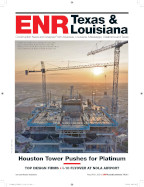The construction manager for the $3.5-million partial rehabilitation of the 122-year-old Texas State Capitol in Austin was under a strict deadline—the job had to be completed in seven months. Despite a longer-than-expected lead paint removal process and outdoor temperatures that reached triple digits, crews managed to complete the work on time and 2% under budget. And there were no lost-time injuries.

A meticulously drawn yet low-tech wall chart helped the contractor keep the job moving. “That progressing tool was probably the most important part of the whole project,” says Peter Narvarte, project manager for Flintco Cos. of Tulsa, Okla., the CM-at-risk. “That’s how we conveyed to the painter, the scaffolder, the repair guys and the owner how many more sectors [were left to do] and how many days we had [for each].”
Taking advantage of a buyer’s market, the State Preservation Board (SPB) decided to go ahead with the project, which it had considered for seven years. In addition to lead paint removal, work called for repainting the elaborate shaped-sheet-metal ceiling grid of the 11,500-sq-ft legislative chamber and repairing the leaky dome of the four-story building’s iconic rotunda.
The colonnaded rotunda of the 385,000-sq-ft Capitol, designed in the Renaissance Revival-style by Elijah E. Myers, rises 300 ft above grade. A 20-ft-tall Goddess of Liberty statue, holding a gold star symbolizing the Lone Star State, stands atop the dome.
The granite-clad building was renovated in the 1990s, during a project that also added a four-level underground structure outside the original 95,000-sq-ft footprint. Since then, weather had taken its toll on the Capitol, says Dave Stauch, project manager with HS&A, the project’s local management firm.
Flintco had only from June until December to get the work done. To get a handle on the chamber, Flintco divided the space into 190 grids, matching the ceiling’s own grid pattern, and set daily goals.
Progress was stymied by the lead paint abatement. Narvarte calls the work a “tricky business” because it could take as many as three passes at the same spot to remove all the paint.
To keep the extra passes from wreaking havoc on the schedule, Flintco decided work would have to take place concurrently in all quadrants of the room. As abatement wrapped up in the first quadrant and moved to the next, repair crews came in, followed by the priming and painting trades.
Flintco also divided the 75,000-sq-ft dome, clad in sheet metal, into 20 segments and monitored progress on sheet-metal repairs and repainting using the same wall chart. Water had penetrated the outer dome, bubbling some plaster and paint on the interior, which the SPB repaired concurrently with Flintco’s work. As is typical on projects, Flintco documented all aspects of the repairs with photographs.
Flintco had limited historic restoration experience. But HS&A, which had led the 1990s effort for SPB, had the necessary experience. Flintco’s considerable expertise in renovation work was critical. “We wanted to hire a contractor we could trust to maintain production rates,” Stauch says.
Article toolbar


